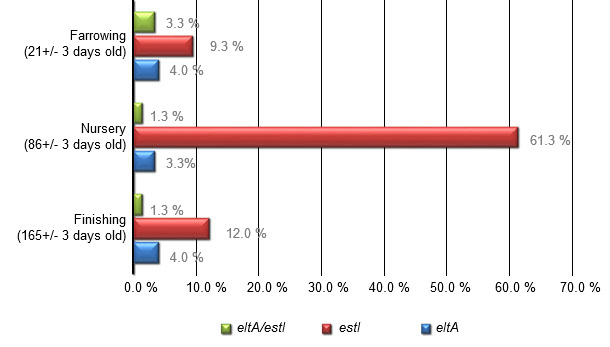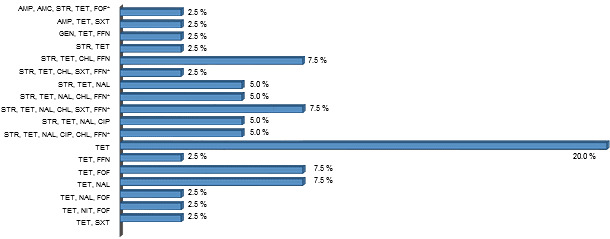Enterotoxigenic Escherichia coli (ETEC) is the major pathogen responsible for neonatal diarrhea (ND), post-weaning diarrhea (PWD), and edema disease (ED) in pigs. Although colibacillosis normally affect young animals, during lactation and nursery period, ETEC can be also isolated from growers and finisher pigs. ETEC adhere to the small intestinal microvilli via fimbriae, such as F4, F5, F6, F18 and F41, and produce enterotoxins that act locally on enterocytes. The ETEC enterotoxins are classified based on their thermal stability into heat-labile LTa (eltA), LTb (eltB) and heat-stable STa (estI), STb (estII) and EAST1 (astA) toxins. It has been demonstrated that the presence of intestinal ETEC is not sufficient to cause clinical diseases (Dewey CE et al, 1995). The pathogenesis of ETEC is complex, and numerous genes have to be regulated in order to produce, activate and secret virulence factors. Environmental signals, such as temperature, ion concentration, Fe++, pH, O2 concentration can modulated the expression of these genes (Nagy B et al, 2005), and environmental signals might turn off/on different virulence factor genes. In addition numerous husbandry factors, including dietary changes, multisource early weaning, and continuous flow, may have implication in the presence of clinical forms of ETEC.
In this study we investigated the prevalence of ETEC positive pigs in farms without clinical signs of diarrhea, and the antibiotic resistance pattern observed amongst ETEC strains isolates. We conducted a cross-sectional study including 11 farms with no history or clinical signs of colibacillosis. Swine units were included by one of the following criteria: sow herd size (225 ± 30) and finisher pigs delivered to slaughter/year (at least 2,500 finisher pigs to market/year). Selected farms have the same management style and are farrow-to-finish. Ninety rectal swabs were collected from each farm to determine the presence of eltA, estI, or both, and the subsequent prevalence of different genotypes in each production stage. Thirty randomly selected pigs from each production stage were sampled as follows: farrowing (weaning piglet, 21 ± 3 days old); nursery (nursery piglets, 86 ± 3 days old); finishing (finishing pigs, 165 ± 3 days old). Pigs considered being ETEC positive (ETEC+) were those in which eltA, estI, or both genes were detected.

Prevalence of eltA and estI genes in non-diarrheic pigs
From a total of the 990 samples screened, 150 (15.2% – 95.0% CI ± 2.24) samples were positive for the presence of eltA, estI or both. Out of these 150 ETEC+ pigs, 82.7% (95.0% CI ± 6.05), 11.3% (95.0% CI ± 5.07) and 6.0% (95.0% CI ± 3.8) were positive for estI, eltA and estI/eltA respectively. The overall percentage of ETEC+ animals increased from 16.6% (95.0% CI ± 5.95) in the farrowing phase to 66.0% (95.0% CI ± 7.58) in the nursery phase. The percentage of carrier pigs abruptly declined to 17.3% (95.0% CI ± 6.05) in the finisher population. ETEC+ pigs were present in 10 of the 11evaluated farms. Among the 150 ETEC+ pigs, 40 ETEC strains (26.7%) (95.0% CI ± 13.71) were isolated from 30 nursery samples (75.0%) (95.0% CI ± 13.42), 8 finishing samples (20.0%) (95.0% CI ± 12.4), and 2 farrowing samples (5.0%) (95.0% CI ± 6.75).

Figure 1: Prevalence of eltA (toxin LT) and estI (toxin STa) genes obtained from the confluent growth zone in Tripticase Soy Broth (TSB).
A total of 90 rectal swabs were collected from each farm to determine the presence of eltA (toxin LT) and estI (toxin STa) genes and the subsequent prevalence of different genotypes in each production stage. Thirty randomly selected pigs, from three different stratums (farrowing: weaning piglet, 21 ± 3 days old; nursery: nursery piglets, 86 ± 3 days old; finishing: finishing pigs, 165 ± 3 days old), based upon the age and stage production were sampled.
Antimicrobial susceptibility of ETEC strains
Two of the 40 ETEC strains were susceptible to all antimicrobial agents evaluated. All of the strains were susceptible to amikacin (AMK), colistin (CST), cefotaxime (CTX), and cefoxitin (CXT). Thirty-eight (95%) strains were resistant to at least one antimicrobial tested, and all of these strains showed resistance to TET. Eighteen different antimicrobial resistance profiles were observed. Multiple antibiotic resistance (MAR) to more than three antibiotics was observed in 52.5 % of the strains (Figure 2).

Figure 2. Antimicrobial resistance profile of ETEC strains from non-diarrheic pigs.
Out of 40 ETEC+ isoalte, 18 different multiple antibiotic resistance (MAR) paterns were observed, A perencetga of cases with each specific MAR patern is repsesented with horizontal bars. Ampicillin (AMP), Cephalothin (CET), Amoxicillin/clavulanic acid (AMC), Gentamicin (GEN), Streptomycin (STR), Tetracycline (TET), Nalidixic acid (NAL), Ciprofloxacin (CIP), Chloramphenicol (CHL), Florfenicol (FFN), Trimethoprim-sulfamethoxazole (SXT), Nitrofurantoin (NIT), Fosfomycin (FOF). * = Multiple antimicrobial resistances
During this study, we observed that numerous ETEC genotypes cohabit and circulate in swine populations without clinical manifestation of neonatal diarrhea, post-weaning diarrhea, or edema disease in different production stages. In addition numerous antibiotic resistant profile were observed in ETEC isolates obtained from non-clinical affected animals. The information generated is important not only for diagnostic and epidemiological purposes, but also for understanding the dynamics and ecology of ETEC in pigs in different production stages that can be potentially the cause of clinical colibacillosis.




